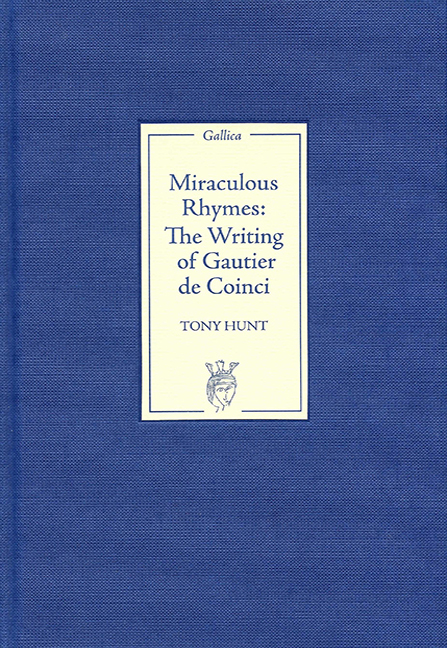Summary
In an attempt to appeal to two audiences, a broadly based one of medievalists and a more specialised group of Old French scholars, I have divided the following study into two parts. The first half offers a general presentation of Gautier and an overall survey of the Miracles de Nostre Dame. In the belief that this may be of interest to general readers and medievalists with no specialisation in French I have translated all extended quotations from the Old French and paraphrased short quotations. The second part of the book is much the more technical, dealing with wordplay of such precision and subtlety that translation would have done nothing but obscure it, besides greatly lengthening the chapters. In recognition, however, that Gautier's lexis is often individualistic, not to say recondite, I have supplied marginal glosses where I judged them to be helpful.
I would like to thank the Publisher's reader for valuable and encouraging observations.
Note: References to Gautier's miracle stories follow the pattern established by his principal editor, V. F. Koenig, with slight modifications: the initial number (1 or 2) indicates Books 1 and 2 of the Miracles. The following abbreviations identify the individual items: Pr = Prologue; Mir = Miracle (including 2 Mir 9 ‘L'Empeeris qui garda sa chastee contre mout de temptations’); Ch = Chanson; Chast = 2 Chast 10 ‘Des nonains de Nostre Dame de Soissons’; Ep = Epilogue; Dout 34 = ‘De la misere d'omme et de fame et de la doutance qu'on doit avoir de morir’; Sal = ‘Les salus Nostre Dame’; 2 Prière 37, 38 = ‘C'est une oroison a Nostre Dame’; 2 Prière 39 = ‘Les cinc joies de Nostre Dame’; 2 Prière 42 = ‘Galterus ad Dominum’.
- Type
- Chapter
- Information
- Miraculous RhymesThe Writing of Gautier de Coinci, pp. vii - viiiPublisher: Boydell & BrewerPrint publication year: 2007



